| Author | Message | ||
David Lacey New User Username: dlacey Post Number: 10 Registered: 11-2010 |
All, I know that the RR363 formulation has been discussed a lot here and many have strong opinions about fluid substitution. I don't want to reignite debate, but just give an observation. Out here in the jungle we are blending castor oil with DOT3 quite happily, but recently a friend encountered a miscibility issue...Castor wouldnt mix. It turns out that Castrol DOT3 and Shell DOT3 are quite different & although castor blends well with castrol it doesnt like shell. I find that quite interesting, as I always thought that brake fluid was brake fluid no matter what brand... | ||
Omar M. Shams Prolific User Username: omar Post Number: 288 Registered: 4-2009 |
Dear David, I use Caltex. I know you can get it in Malaysia. I blend with Caltex Dot 3 and it works fine. It has served me well for 4 years on three different cars. Thnaks Omar | ||
Jan Forrest Grand Master Username: got_one Post Number: 406 Registered: 1-2008 |
I've had a litre or so of premix using food grade CO and 'Comma' synthetic DOT4 fluid in a sealed 5 litre bottle for 3 years and there are absolutely no signs of them separating out. Admittedly the bottle has been kept in the house all that time. Since we are now rapidly aproaching Winter in the UK I'll transfer the bottle to my unheated garage and see how the contents fare over the next few months. | ||
richard george yeaman Frequent User Username: richyrich Post Number: 64 Registered: 4-2012 |
Hi David/Omar/Jan. I would be interested in trying some of this home brew Brake concoction, Where do i start what is the best Formula/Recipe known to work as good or better than the original, I have read somewhere in these pages that for a while R363 was not available in its original form so it would make sense to use something that is conjl | ||
Omar M. Shams Prolific User Username: omar Post Number: 291 Registered: 4-2009 |
Dear Richard, All details are captured in http://au.rrforums.net/cgi-bin/forum/show.pl?17/12821. The composition that I use is 85% Dot 4 and 15% Caster Oil. Please note that this is my formula for my use - I am not advocating that people should try it unless they do so off their own free will. I am merely sharing my experiences as a response to a question. Thanks Omar | ||
richard george yeaman Frequent User Username: richyrich Post Number: 66 Registered: 4-2012 |
Thank you Omar. I shall call it an Omar Special Cocktail. Cheers. Richard. | ||
Brian Vogel Prolific User Username: guyslp Post Number: 117 Registered: 6-2009 |
I can report that I mixed up a 90/10 DOT3/Castor Oil (human pharmaceutical grade) mix in 2009 using SuperTech DOT3 fluid (Wal-Mart's own) and it has remained perfectly mixed since. Mine was not stored under temperature controlled conditions, but was (and is) in an unheated garage that varies from 90+ degrees F in the summer to down to approximately 10 degrees F at coldest in winter. Note: this mix has not been used in the car, as it was part of the experiment to see how this holds up under storage. Since regular castor oil is routinely used as the motor lubricant in model airplanes, which develop temperatures and speeds far in excess of anything the brake pumps in an SY series car are ever subject to, I have no reason to believe that it should not survive and work fine there. I am just finishing the process of rebuilding both accumulators and control valves on one car and doing "revival from the dead" work of all kinds on another. I intend to go with YAK363 (see prior threads for the history of that humorous term) this time around. I am more than a bit surprised to hear that castor oil was not miscible with *any* DOT3 fluid, as it's the main component in DOT3 that it's miscible with. Although there are obviously some manufacturer specific "tweaks" that are possible, they're not all that extensive and should certainly not affect miscibility of castor oil with the fluid. Brian | ||
Jan Forrest Grand Master Username: got_one Post Number: 409 Registered: 1-2008 |
According to the Citroen DS website, where the homebrew formula came from, there can be problems with 'clumping' of the edible CO in sub zero weather conditions. This is allegedly made worse if the mix exceeds 10% CO. As this concentration seems to be at least as good as the original RR363 I never go over that recommendation. However in warmer climes that never see those kinds of conditions it is supposed to be possible to go as high as 20% with no discernable negative impacts on ride, handling or braking quality. | ||
Randy Roberson Frequent User Username: wascator Post Number: 52 Registered: 5-2009 |
Perhaps the problem Jan mentions is the reason for the castor oil being 'ethoxylated, propoxylated' in the RR363. Now, if we could find some of this... | ||
David Lacey Experienced User Username: dlacey Post Number: 11 Registered: 11-2010 |
Hi Brian, I agree, thats why I posted the observation...very surprising as I thought they were all glycol ethers... maybe the 'Shell' fluid here is 'fake'...wouldnt be the first time in Malaysia!! "I am more than a bit surprised to hear that castor oil was not miscible with *any* DOT3 fluid, as it's the main component in DOT3 that it's miscible with. Although there are obviously some manufacturer specific "tweaks" that are possible, they're not all that extensive and should certainly not affect miscibility of castor oil with the fluid. " | ||
Paul Yorke Grand Master Username: paul_yorke Post Number: 883 Registered: 6-2006 |
www.facebook.com/pages/EverythingRollsRoyce interesting mix in this Shadow. How much is 363 wher you are guys? | ||
Omar M. Shams Prolific User Username: omar Post Number: 298 Registered: 4-2009 |
Dear Paul, The link does not work for me. I dont know how much 363 is in Dubai but by gum its not cheap. Omar | ||
Hubert Kelly Frequent User Username: h_kelly Post Number: 62 Registered: 3-2012 |
Hi Paul, I inquired the price of rr363 only this week, €12.99 euro at a MOTOR FACTOR approx 30 miles from me. I can't understand how its so expensive in the U.K.? it appears difficult to get DOT 3 over here(well its not freely available the way it use to be) hk | ||
Peter Talbot Prolific User Username: squerryes Post Number: 170 Registered: 7-2010 |
Another point to consider is the moisture content of the castor oil being used. Castor oil is hydrophilic, i.e. takes up water. Castor oil in a half empty bottle will absorb moisture fron the air above it. If stored in even an un-opened plastic bottle, castor oil will grab any moisture whuch permeates through the plastic. The resultant moisture content might be trivial in absolute terms but significant in this context. Peter | ||
Paul Yorke Grand Master Username: paul_yorke Post Number: 884 Registered: 6-2006 |
Hi Omar, try http://www.facebook.com/photo.php?v=113536702140494&set=vb.480142005358985&type=3 Or if you use facebook search everythingrollsroyce I have no idea what was in the Shadow but if you manage to view the video you can see it was above the level of the filter. I've never seen R363 go this bad so assume that it was some other fluid or mixture in there. | ||
Brian Vogel Prolific User Username: guyslp Post Number: 133 Registered: 6-2009 |
Paul, I've seen multiple instances of RR363 going this bad if it's been neglected for a long time. This is one photo after the top fluid was taken out: 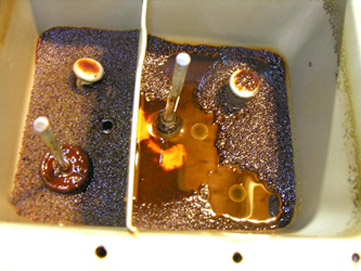 On LRK37110, the '79 SW-II I acquired last January and that had been sitting for approximately 5 years immediately after a full hydraulic system overhaul, the System 2 reservoir had what for all the world looked like algae growing in it. The System 1 reservoir had no solids in it, but the fluid was the color of super strong tea. Brian | ||
Brian Vogel Prolific User Username: guyslp Post Number: 134 Registered: 6-2009 |
Just found the photo of LRK37110's reservoir when I first removed the top. This is before touching anything except the lid: 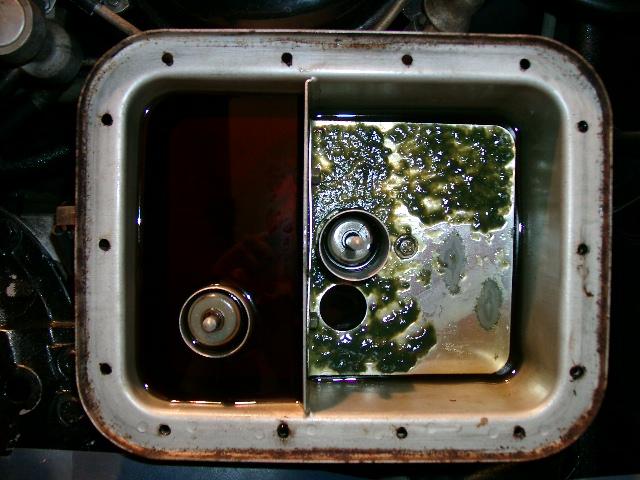 These are photos of what I found in 2009 in the reservoir of SRH33576, my '78 SS-II. I'll note that I had had the entire hydraulic system flushed out in 2006 (by a shop that clearly didn't bother to even take the baffles out or else they would have already known about the destroyed filter you see here): 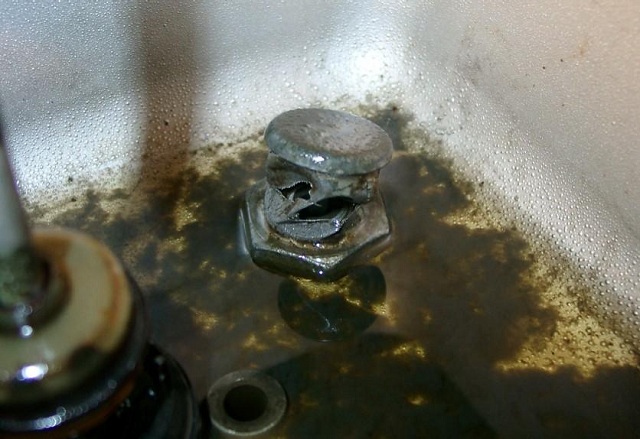 After seeing several of the original filters suffer catastrophic failure (admittedly due to lack of maintenance) I decided I no longer wanted to replace them with OEM ones that are subject to collapse and tearing from sludge. I had these filter pillars machined and then applied the stainless steel mesh. They may clog, which would be fine by me, but they will never collapse and let the crud circulate through the rest of the system. 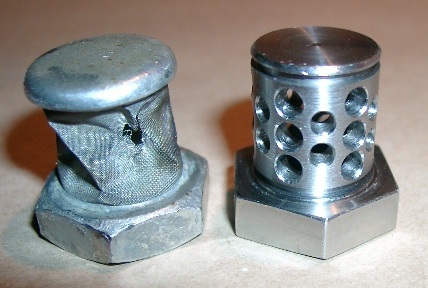 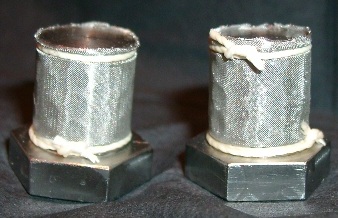  The mesh is attached to the pillars using polypropylene twine, which is virtually indestructible (I tried wire and liked it less) and this mesh is ever so slightly finer than the OEM mesh. These filters are working perfectly. Brian | ||
Paul Yorke Grand Master Username: paul_yorke Post Number: 885 Registered: 6-2006 |
Hi Brian, I've also seen plenty as bad as your photo and many more that were a lot worse. Algae and other pond life is nearly always found in them. The one I did last week had so many solid and crystalline deposits in there that it was solid to above the top of the filter (can just be seen in the top left of picture). About 2.5 cm at least! The red item is the cap I started emptying it out with. If you can get onto the Facebook page there is a video that shows it better. I had to use a lid to dig the deposits out. Not good at all! Your modified filters look like a good idea although hopefully not needed now she is is good hands!   | ||
Geoff Wootton Experienced User Username: dounraey Post Number: 11 Registered: 5-2012 |
This is the reservoir on my 74 SY1 after cleaning. You can see that it is badly pitted. Should I get this replated? I decided to go with it as it is and do occassional checks. My guess is that brake fluid should not react with the steel exposed by the pitted cadmiun plate. 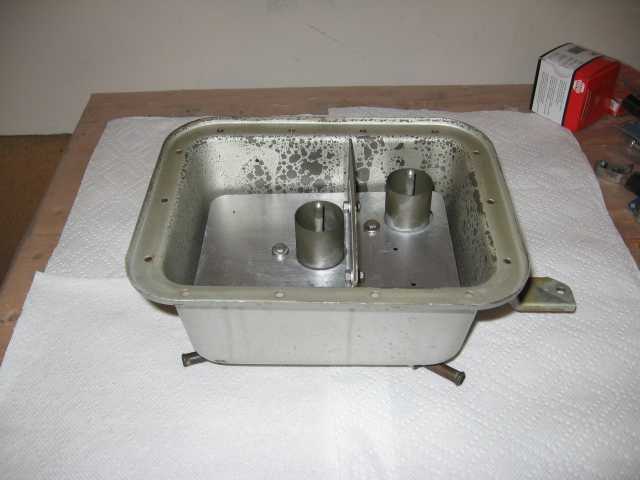 | ||
Brian Vogel Prolific User Username: guyslp Post Number: 135 Registered: 6-2009 |
Geoff, I have yet to see a single reservoir that isn't freshly replated that doesn't have some discoloration in spots. From the photo it looks like the majority of this is not true pitting, but as we all know photos can lie. Since virtually entirely the rest of the system that isn't flexible hosing is steel I can't see why there should be any serious problem. Most reservoirs I've seen are not perfect, but there are no problems with the brakes/hydraulics if routine fluid changes are done approximately once every 2 years in "average" climates or once per year in really humid ones. Brian, who's also transitioning to YAK363 with my next fluid change | ||
Geoff Wootton Experienced User Username: dounraey Post Number: 12 Registered: 5-2012 |
Brian, I'd figured since the fluid comes into contact with a lot of steel anyway there should not be a problem, however it is reassuring to hear your comments. I will be taking the lid off every 1 to 2 years so can keep a check on it. YAK363 - this must be an alternative to the Omar Cocktail. I have also been keeping a track on this and may also follows suit next year. | ||
Brian Vogel Prolific User Username: guyslp Post Number: 136 Registered: 6-2009 |
Geoff, I believe the term YAK363 was coined on these forums. It came from someone making a comment about RR363 and its proposed substitute being "Yak Pee." [But with a slightly more colorful word for "pee" that I'm not permitted to include. Which shocks me a bit, actually. . .] For me YAK363 is either a 90/10 DOT3/Pharmaceutical Castor Oil blend or an 85/15 blend. I've experimented with 90/10 for several seasons of "shelf life" and "does it remain mixed" testing. The Omar Cocktail is the second of the two YAK363 formulae. Brian | ||
richard george yeaman Frequent User Username: richyrich Post Number: 71 Registered: 4-2012 |
HI ALL. Similar story when i first took the lid off SRH19529 in all my motoring life which has been extensive i have never seen anything like this in any other make of car or truck, says a lot for RR363, Lately i have been flushing and bleeding and changing flexible hoses and the variety of muck that i have seen would make you wonder about any brake fluid that has a lot of chemicals added mayby this is why the maker changes the formula now and then. I wonder what horror pictures are lurking in some of these garage Queens. Richard | ||
Mark Herbstreit Frequent User Username: mark_herbstreit Post Number: 97 Registered: 5-2005 |
It is interesting to see Geoff mention cad plating on the tank. I had also assumed the tank to be Cad plated. During the week I took some surface scrapings down to the Lab and discovered only trace Cd. The main component of the coating was Aluminium. The tank is not made of Aluminium so how is it coated? Was it some sort of Al plating or a two pack/epoxy paint finish? What was available in the early sixties? Can someone confirm what the original coating was? Someone must know the secret formula. | ||
Randy Roberson Frequent User Username: wascator Post Number: 53 Registered: 5-2009 |
Perhaps during a previous repair it was painted with aluminum paint, rather than being replated with Cadmium? Just a guess. | ||
Randy Roberson Frequent User Username: wascator Post Number: 54 Registered: 5-2009 |
I looked at the material safety data sheet for Castrol RR363, and noted the chemical makeup of it: DOT 3 brake fluid and "castor oil, ethoxylated, propoxylated" From the Chemical Handbook, this is what is listed for "castor oil, ethoxylated, propoxylated" CAS No. 72986-44-8 Chemical Name: Castor oil, ethoxylated propoxylated Synonyms: Castor oil, ethoxylated propoxylated;Castor oil, ethoxylated propoxylated (30-70 EO, 20-50 PO) CBNumber: CB91212548 As it has a CAS number which identifies it, our task is to find a supplier who will sell this in a reasonable quantity, then mix it with DOT 3 brake fluid, and there we have it: the proper homebrew. So far, I have not found a supplier; however, Castrol buys it somewhere, and occasionally mixes (or has someone mix) up a batch in the United States (all the RR363 bottles I have seen say "made in USA") and bottles it. I think the last I bought cost about $40 US per bottle, all in.) As long as I can get it at an acceptible price, fine. When I can't anymore, it will be on to a homebrew, no worries. | ||
Omar M. Shams Prolific User Username: omar Post Number: 299 Registered: 4-2009 |
Dear All, I think it is my moral duty to take the lid off my Green Wraith II's Hydraulic reservoir and take a photo of whatever is there to share with you. I want to do it on this particular car because I have not touched the reservoir on it for a few years now. As you know I have been running my cars with my OMR363 blend for approximately 4 years now and have been pleased with the performance of my cars on this fluid. I have to very quickly say that I operate my cars in a hot country that rarely sees temperatures drop to single digits. Thanks Omar | ||
Omar M. Shams Grand Master Username: omar Post Number: 301 Registered: 4-2009 |
On the issue of plating, I remember my days of working closely with Rolls-Royce Avon gas turbines where it was common practice to coat turbine blades with platinum aluminide or pt-al. This coating is great for corrosion protection but is usually associated with high temperature. My thoughts are that it may have been overkill in the application of our cars. I dont think Rolls-Royce Motors would have chosen this coating for the Hydraulic reservoirs but I can't think what other coating would have an Aluminium content. | ||
Randy Roberson Frequent User Username: wascator Post Number: 55 Registered: 5-2009 |
A friemd had occasion to take an aircraft prop to a repair and inspection shop at Memphis, Tennessee, and they were well-equipped to cadmium-plate as it is needed as part of certain prop mechanism repairs.probably not cheap, though, but possible. | ||
Peter Talbot Prolific User Username: squerryes Post Number: 171 Registered: 7-2010 |
CAS No. 72986-44-8 is actually specified in the Castrol Safety Data Sheet for RR363 - Product Code 450597-GB10. Easy one this, I thought, got the info, just find a Supplier. No such luck - I've spent hours on the phone with(and sent loads of emails to)my many contacts and have come up with a total blank. Peter | ||
Peter Talbot Prolific User Username: squerryes Post Number: 172 Registered: 7-2010 |
RR363 (RR363L1) is available from Flying Spares at £14.50 (Excl.VAT), £17.40 (Incl.VAT), for 1 litre - I've no idea as to delivery cost. Peter | ||
Brian Vogel Prolific User Username: guyslp Post Number: 137 Registered: 6-2009 |
Well, even if one can exclude VAT that still puts RR363 at $23/litre, without delivery, which from the UK to the US is quite steep. Having over $100 invested in brake fluid alone is, for some of us, a no-go just on principle. And that's only if you're using regular DOT3 to do the once-every-two-years system flush before doing the final fill with RR363. Brian | ||
Peter Talbot Prolific User Username: squerryes Post Number: 174 Registered: 7-2010 |
Brian I appreciate that RR363 is but expensive but what are the options - fail to flush/replace every two years and you risk building up a $$$$ major repair cost in the future or use a Homebrew of uncertain provenance and of questionable performance. As far as I can establish, ALL of the Castrol RR363 around is made in the USA so there must be a USA supplier which would cut the shipping costs. I'll check this out and report back. Peter | ||
Brian Vogel Prolific User Username: guyslp Post Number: 138 Registered: 6-2009 |
Peter, Good luck. The least expensive RR363 source I've found in the U.S. in the last several years is H.D. Rogers and they are $110 per 4-bottle set or $29.95 per single 1-litre bottle, without shipping. Based upon my research, and upon the number of people I've now had communication with who've been using other than RR363 for at least 3-5 years now, I'm perfectly OK with using a DOT3/Castor Oil mix. I know of one person who's used straight Prestone DOT3 for over 5 years now, but prefer to spike with a small percentage of castor oil for lubrication. Based on the MSDS for RR363 I simply do not believe it has any mystical properties. It's DOT3/4 fluid with a bit of castor oil in it. If you can find any reasonably priced source for RR363 (read: $15 US or less per liter) I'd certainly prefer to use it. I've simply had enough of both being price gouged on this stuff and having, to put it kindly, an irregular supply stream. Brian | ||
Peter Talbot Prolific User Username: squerryes Post Number: 175 Registered: 7-2010 |
Brian I just put "Castrol RR363" into www.ebay.com - thought this might give a USA source, and it did. Foley Parts are offering a 3 x 1 Litre pack of Castrol RR363 at US$ 106.00 with free shipping to the lower 48 States (Alaska & Hawaii are not included) = US$ 35.33 / litre delivered. Peter | ||
Richard Treacy Grand Master Username: richard_treacy Post Number: 2709 Registered: 4-2003 |
Word has it that Castrol Australia is now selling RR363 from Belgium. It will be interesting to see if the price rises from the A$13/litre (A$11.8 plus tax) I paid earlier this year. I’ll enquire next time I pass the local Castrol depot – it normally stocks RR363 but have run out from time to time over the past decades as it is not a large depot. Previously RR363 sold here was marked as Made in the USA, so maybe the Crewe franchisees in the USA have imposed a restrictive trade practice to prevent it from being sold by Castrol direct or by any non-franchised outlet anymore. The price in the UK is presently £10 plus tax (for example at Opie Oils www.opieoils.co.uk ) but I am sure that it may be found at more favourable prices. Unless the price hikes by a huge amount from these sorts of levels I could not be bothered to try an alternative. That Castrol Australia has re-sourced RR363 suggests that the stuff will be around for quite some time yet. If we want it to continue to be available then we had better buy it to keep BP-Castrol interested. RT. | ||
Geoff Wootton Experienced User Username: dounraey Post Number: 13 Registered: 5-2012 |
The current AUDUSD exchange rate is 1.04 = 12.27 US dollars.That's half price. I guess the postal charges would kill any price advantage. | ||
Randy Roberson Frequent User Username: wascator Post Number: 56 Registered: 5-2009 |
Like Peter I have searched diligently for a source for "Castor oil ethoxylated propoxylated", but have not found any, although we know it exists, and we know that someone in the United States is blending the RR363 for Castrol UK. I did find a custom blender of lubricants in the US who blends factory fill lubricants for auto makers, and they blend some products for Castrol, but no mention of RR363: Chrysan Industries. Best I can tell, castor oil has some unique lubricating properties among vegetable oils, and the two additional words indicate chemical treatments which involve adding properties of a surfactant and increase miscibility and emulsibility. I found some interesting info on a Citroen hobbyists' site as well. I really have no interest in bypassing Castrol; I am glad they are willing to continue to provide the stuff, as they can't be making any money on it (we in the fraternity ought to send them a note of recognition). Now I am simply curious. I don't think the makeup or source of RR363 is so much a secret as it is too small to be noticed. By the way: you might enjoy reading about castor oil as I have. Amazingly useful product of the plant world.Try the International Castor Oil Association (www.icoa.org), and this extensive treatise: http://www.scribd.com/doc/30116043/Castor-Oil | ||
David Gore Moderator Username: david_gore Post Number: 1155 Registered: 4-2003 |
I have been following this discussion with great interest and have not contributed as my views have been expressed many times in this forum. However, I think I can make a new contribution on the ethoxylated/propoxylated castor oil in the postscript to this post. Ethoxylation of an organic compound involves subjecting it to a chemical reaction involving Ethylene Oxide, a suitable catalyst [e.g.Potassium Hydroxide] and possibly Nitrogen under high pressure and temperature to create surfactants which are miscible with other fluids and also cling to surfaces. Both of these characteristics are obviously highly desirable for lubricating the hydraulic pumps. Propoxylation is the same as ethoxylation with polyethylene oxide [aka polyethylene glycol] being substituted for ethylene oxide. Ethylene Oxide has serious OHSA and carcinogenic risks associated with its use and I would expect its use will be restricted to products where no suitable alternatives exist. Polyethylene oxide has no such risks and is widely used in cosmetics and pharmaceuticals for this reason. So where does this leave us? The possible uses of modified castor oil as an extreme pressure lubricant appears confined to the automotive and aviation industries. Almost all applications in these industries have alternative lubricants available and/or being used at the present time and the only use I can think of is an extreme pressure additive to glycol fluids of which RR363 is the obvious example; there may be other specialist applications in hydraulics of which I am not aware. This essentially means modified castor oil would be a special order only product with corresponding minimum order quantities that could represent many years usage so the chances of purchasing small quantities from a reseller are miniscule to non-existent. This could also explain the on-off availablity of RR363 as the demand will fluctuate and unable to be predicted with any degree of certainty. If the future availability of RR363 is a priority, we have to continue purchasing this product for the manufacturer to keep it in their product range. With regard to YAK 363 and variants, the main problem with using straight castor oil as a lubricant is the problem encountered by model airplane and vintage motor bike enthusiasts with gum formation over time. Whilst this is a problem, I have also heard of situations where the gum deposits function as a seal to control by-pass leakage due to worn parts. Use of straight castor oil as the additive doesn't appear to create problems in hot dry climates however I have not been able to find any references to its performance in high-humidity environments where the fluid is contaminated by water from condensation. In cold climates, maintaining miscibilty may be a problem and appropriate long-term testing is needed to indicate whether this is a concern. POST-SCRIPT: I have just become aware that polyethoxylated castor oil is made by the Bayer Company mainly for medicinal applications and is marketed under the name Kolliphor EL. See the following links for more information: http://www.pharma-ingredients.basf.com/Products.aspx?PRD=30554032 http://www.pharma-ingredients.basf.com/Statements/Technical%20Informations/EN/Pharma%20Solutions/03_111139e_Kolliphor%20EL.pdf The data sheet quotes the smallest quantity is a 60Kg drum - whether Bayer will supply smaller quantities would be an interesting enquiry. | ||
Brian Vogel Prolific User Username: guyslp Post Number: 139 Registered: 6-2009 |
David, I also spent a part of last night doing heavy digging into castor oil in its EP form and sent queries to two companies in the US who market it. Haven't gotten a reply from either, though. This PDF file from a company named Croda shows just how many "twists" on EP there actually are. From what I've been able to determine the PEG number refers to how hydrophilic or hydrophobic the oil is ans what it is able to combine with to create either a liquid or a soft solid. Brian | ||
David Gore Moderator Username: david_gore Post Number: 1158 Registered: 4-2003 |
Brian, The PEG number represents the number of discrete non-bonded components in the polyethylene glycol produced by the polyethoxylation process. The scientific name for these components is a "moiety". PEG-40 means the glycol has 40 different elements and compounds making up the final product. As far as I can ascertain, the PEG number has no relationship to the physical form or application of the product. It is just an indicator of the type of glycol. I am no organic chemist and any further explanation requires input from a suitably experienced and qualified person. | ||
Peter Talbot Prolific User Username: squerryes Post Number: 177 Registered: 7-2010 |
I think what is comes down to is: we just can't find a source of CAS No.72986-44-8 so I'm going to stock up on RR363 rather than risk using a homebrew mix. Peter | ||
Hubert Kelly Frequent User Username: h_kelly Post Number: 63 Registered: 3-2012 |
I bought an old Shadow 1 a year ago for parts. The previous owner had paid over 10k stg for it approx 5 years ago, it was driving M.O.T. etc.HE left it to a garage to have some work done to brakes.. you guessed it.. the old girl died due to incorrect brake fluid.I sold it 2 months ago engine gearbox rolling shell for 400 euro. I guess what I am saying is, everything I know about the Rolls Royce Silver Shadow is thanks to this site, personally from what I have read over the last 2 years I cant' justify the risk of using an alternative brake fluid, for the price of a tank of petrol. |